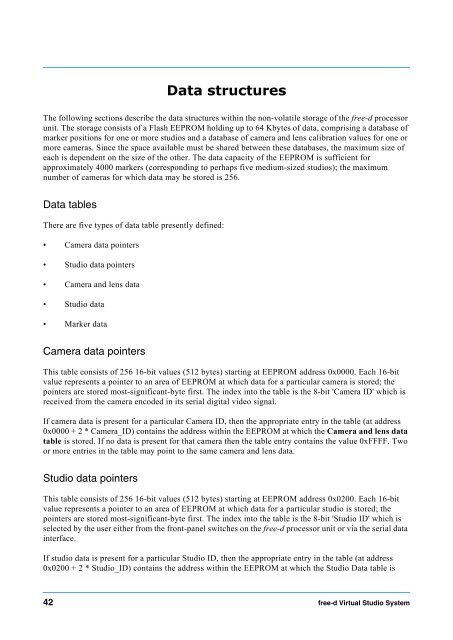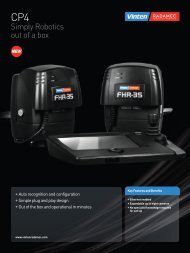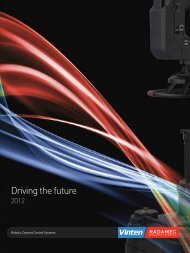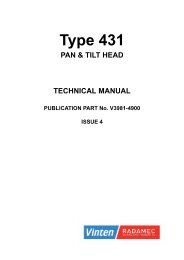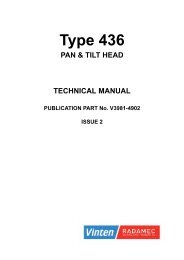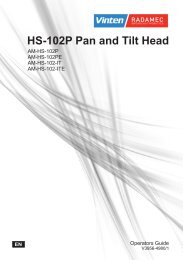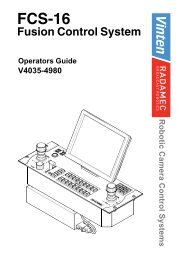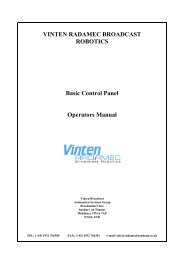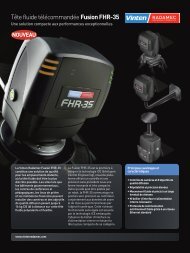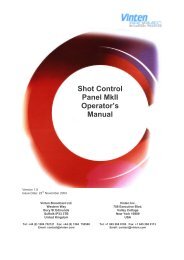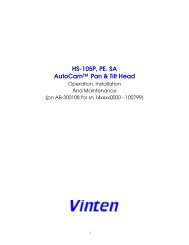free-d Virtual Studio System Operators Guide - Vinten Radamec
free-d Virtual Studio System Operators Guide - Vinten Radamec
free-d Virtual Studio System Operators Guide - Vinten Radamec
You also want an ePaper? Increase the reach of your titles
YUMPU automatically turns print PDFs into web optimized ePapers that Google loves.
Data structures<br />
The following sections describe the data structures within the non-volatile storage of the <strong>free</strong>-d processor<br />
unit. The storage consists of a Flash EEPROM holding up to 64 Kbytes of data, comprising a database of<br />
marker positions for one or more studios and a database of camera and lens calibration values for one or<br />
more cameras. Since the space available must be shared between these databases, the maximum size of<br />
each is dependent on the size of the other. The data capacity of the EEPROM is sufficient for<br />
approximately 4000 markers (corresponding to perhaps five medium-sized studios); the maximum<br />
number of cameras for which data may be stored is 256.<br />
Data tables<br />
There are five types of data table presently defined:<br />
• Camera data pointers<br />
• <strong>Studio</strong> data pointers<br />
• Camera and lens data<br />
• <strong>Studio</strong> data<br />
• Marker data<br />
Camera data pointers<br />
This table consists of 256 16-bit values (512 bytes) starting at EEPROM address 0x0000. Each 16-bit<br />
value represents a pointer to an area of EEPROM at which data for a particular camera is stored; the<br />
pointers are stored most-significant-byte first. The index into the table is the 8-bit 'Camera ID' which is<br />
received from the camera encoded in its serial digital video signal.<br />
If camera data is present for a particular Camera ID, then the appropriate entry in the table (at address<br />
0x0000 + 2 * Camera_ID) contains the address within the EEPROM at which the Camera and lens data<br />
table is stored. If no data is present for that camera then the table entry contains the value 0xFFFF. Two<br />
or more entries in the table may point to the same camera and lens data.<br />
<strong>Studio</strong> data pointers<br />
This table consists of 256 16-bit values (512 bytes) starting at EEPROM address 0x0200. Each 16-bit<br />
value represents a pointer to an area of EEPROM at which data for a particular studio is stored; the<br />
pointers are stored most-significant-byte first. The index into the table is the 8-bit '<strong>Studio</strong> ID' which is<br />
selected by the user either from the front-panel switches on the <strong>free</strong>-d processor unit or via the serial data<br />
interface.<br />
If studio data is present for a particular <strong>Studio</strong> ID, then the appropriate entry in the table (at address<br />
0x0200 + 2 * <strong>Studio</strong>_ID) contains the address within the EEPROM at which the <strong>Studio</strong> Data table is<br />
42 <strong>free</strong>-d <strong>Virtual</strong> <strong>Studio</strong> <strong>System</strong>


